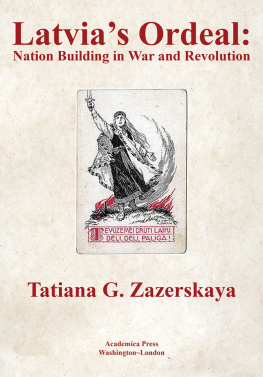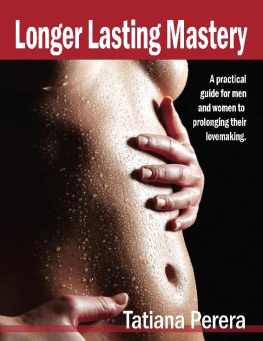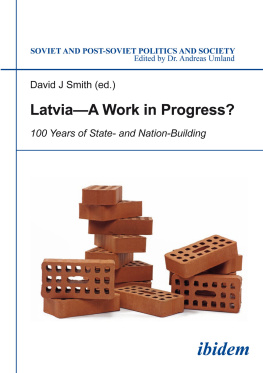LATVIAS ORDEAL:
NATION BUILDING IN WAR AND REVOLUTION
From ancient times the Latvians).
After several wars, Swedish and Polish hegemony in the Baltic region ended with the regions integration into the Russian Empire during the Great Northern War of 1700-1721. The main consequence of this continuing feud was religious differentiation the Latvian people were split between Sweden and Poland. The former became Lutherans, and the latter, mainly Latgalians, remained Roman Catholics.
Following Peter the Greats state reforms, the Baltic region was divided into the Russian provinces of Courland, Livonia, and Estland generally named Baltic or Ostsee region of the Russian Empire, while Latgale was a part of Vitebsk province.
Despite the regions integration into the Russian Empire, Baltic Germans maintained their historic local political power, social status, and wealth, largely because the tsarist regime relied on German merchants and their guilds and councils to administer the cities, and on German landowners to administer the countryside. Many Baltic Germans also entered Russian government and military service, in which they achieved a great deal of distinction.
National Latvian awareness began to blossom from the 1860s. In the Baltic region, the Germans referred to themselves as Balts (Balten), whose language and culture was German. The identities and cultures of the peasant were labeled as non-German (Undeutsch), and their language a peasant language (Bauernsprachen).
At the beginning of the twentieth century, language discrepancies became more prominent between the German-Russian rulers and the common people: the Latvians, Latgale, and other ethnic minorities. The rulers spoke German, whereas Russian was used for official purposes. The common folk used an assortment of languages that could be described as varieties of Latvian, including Latgalian, and other minority languages, including Estonian, Lithuanian, Polish, Romani, and Yiddish.
National independence aspirations were awakened by two factors by the end of the nineteenth century. First, the Russian Empires authorities pushed for the Russification of the public and administrative life, and second, the local German nobility pushed for the Germanization of daily life, which was inherently linked to economic factors.
Initially, Latvians striving for social recognition embraced the German language and way of being. In response, tsarist Russia launched a Russification policy in an attempt to neutralize the local power of the Germans through the introduction of Russian in all Latvian schools and in the government bureaucracy. Russification gave an unintended impetus to the nation-building movement in Latvia. Countering German influence, new career possibilities were unraveled for upwardly mobile Latvians as officers in the army, navy, police, and other official tsarist structures.
Latgale and its people witnessed a different development from the rest of Latvia. The region was not administered by a Baltic German nobility but had a strong Polish influence and was mostly Catholic. The Russian population in Latgale primarily consisted of Old Believers (staroobriadtsy), a religious group that saw its identity not solely in terms of the Russian language but also in opposition to the official Russian Orthodox Church. Until 1904, Latgalian Catholics were forbidden to any print texts in their native language, including prayer books. The regions cultural and educational needs were completely ignored: study of the local native language was not allowed in local schools. In 1917, a local national movement pushed for Latgale to become part of Latvia, having never been satisfied with the Latgale languages status as a dialect of Latvian.
With the emergence of a national Latvian intelligentsia, the only guarantee of the nations survival was a revival of the cultural legacy of the ancient Baltic peoples. The use of Latvian was no longer regarded as a sign of illiteracy or lack of culture; instead pride in the Latvian language was cultivated throughout the country. Locally, the Latvian intelligentsias resort to national identity was based on Latvian popular culture, especially folk poems (dainas) from the late medieval period. A spiritual movement called Devotion to God (dievturba) became the basis of national self-identification.
Another part of the Latvian intellectual outlook was a devotion to internationalism. They led political movements against Russian and German authorities, especially during the violent events that took place in Latvia during the Russian Revolution of 1905.
This first Russian Revolution began in St. Petersburg on January, 9, 1905, known as Bloody Sunday due to the armed suppression of peaceful protesters. The ripple effects unleashed the first demonstrations and strikes in Latvia a couple of days later. Members of the Latvian Social Democratic Workers Party (LSDSP) and other political groups launched mass protests. In response Russian government police fired on some 10,000 Latvian demonstrators along the Daugava River in Riga on January 13, 1905, resulting in the deaths of 73 people. In retaliation, the properties of many Baltic German landowners were ransacked. Forty-one ethnic Baltic Germans were killed during this revolutionary year: twenty-one in and around Riga, fourteen in Courland, five in southern Livonia, and one in Estland. Among them were two subjects of the German Empire (Reichsdeutschen). Some 2,500 Latvians were killed during the revolutionary events, and several hundred more were executed in pacification operations in 1906.
An increase in support for leftist political parties resulted not only with tsarist repression but also from local industrial growth. This reduced British economic influence in the region, which was replaced by Germanys. Economic development also drew an influx of workers from other parts of the region and the Russian Empire.
The uprising in Latvia in 1905 also initiated an intense increase in national consciousness. It was characterized by general defiance of the Baltic Germans who had been living in the region for centuries, and by the common desire for independence for all ethnic Latvians either under the umbrella of the European powers or as a republic inside a democratized Russia.
Latvian patriotism was reborn with new vigor during the First World War, when the territories of the Baltic provinces were occupied by German troops. In 1915, tsarist Russia government started to close down, dismantle, and evacuate factories and plants from Riga to the Russian interior. After the industrial plant evacuation, the population was also forced to migrate. In September 1917, just before the Bolshevik coup in Petrograd (as Russias capital had been renamed in 1914), Germany occupied Riga and the Baltic islands off the cost of Estonia.











